
Italian postcard by NPG, no. 643. Photo: Sciutto. Italia Vitaliani. Gigi Sciutto was a famous Genovese photographer in the early 1900s. He supposedly shot the first film footage on Genova around 1897.
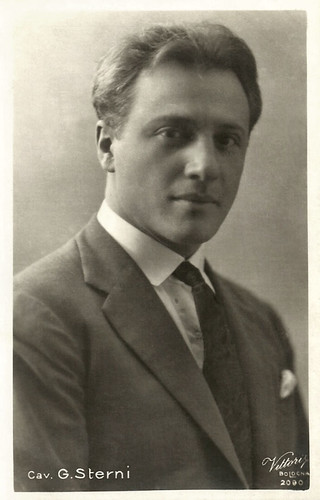
Italian postcard by Vettori, Bologna, no. 2000. Giuseppe Sterni.

American or British postcard, no. 97. Editor unknown. Giuseppe Sterni.
A representative of the new school of acting
When Italia Vitaliani (1866-1938) acted as the mother in Giuseppe Sterni’s film La madre in 1916-17, she was already for decades a highly acclaimed stage actress, rivalling Eleonora Duse, whose 'first cousin once removed' she was. Thanks to her parents and uncle, actor, playwright and artistic director Cesare Vitaliani, Italia had had a comet-like stage career, becoming in 1892 even 'capocomico', artistic director, but also the administrator. She was one of the first women to perform this profession in Italy, and she did so well that people called her 'a perfect gentleman'.
Vitaliani was mentioned as a representative of the ‘new school of acting’ which also included her cousin Eleonora, Emma and Irma Grammatica, and Virginia Reiter. Vitaliani was a serious rival of her cousin Eleonora; both had a liking for the modern repertory and the ‘natural’ performance. Italia toured capitals but also small towns, staging Mary Stuart, Hedda Gabler, and Elisabeth of England, always with the woman at the centre.
In the 1890s she did a tour in Russia and Romania but also travelled to Spain and South America, where she was an acclaimed actress. In 1907 she founded a theatre company with her cousin Carlo Duse (1866-1937), whom she married. They performed repertory by Emile Zola, Henrik Ibsen, Alexandre Dumas and Maxim Gorki, but also by Duse himself. Playwright Roberto Bracco wrote: "The art of Italia Vitaliani is made of such subtle intentions, so humanely intimate, so exquisitely precious, that one cannot exactly judge her if one is not gifted of an equally fine aesthetic perception".
Sources strongly differ about Vitaliani’s film career. Italia Vitaliani, who only occasionally performed in films, made her screen debut with the title role in the short Fedra (Film d’Arte Italiana, 1909-1910), based on Jean Racine’s famous stage play. IMDb does not mention her title role in the Milano Film melodrama La madre/The Mother (Giuseppe Sterni, 1917). The film was based on the play 'La mare' (1907) by the Catalan writer and artist Santiago Rusiñol, which Vitaliani had performed with great success all over Spain in 1907.
Actually, Vitaliani had been a regular performer of Rusiñol’s plays around the 1900s, to great acclaim in Spain, in particular in Barcelona, and to Rusiñol’s own great satisfaction, praising her restrained, realist action. In 1901 he wrote: “The art of Italy Vitaliani is not of great plastic lines, nor does it wear the broad garb of Roman statues or Greek tragedies. It is of delicate lines and subtle emotions; it is art of actual life, the art of rare sensations, of lip-smacking phrases and exquisite perfumes; the art of feeling the nerves vibrating softly like the strings of a finely tuned lyre giving notes of subdued colours, of dying smiles and of all the shades of modern suffering.”
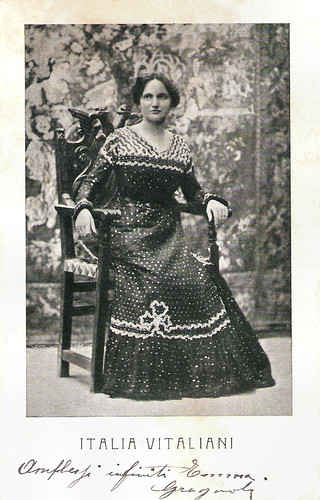
Italian postcard. Mailed in Rome, Monteverde, early 20th century. Italia Vitaliani.
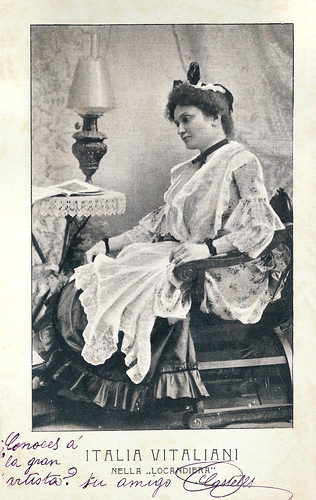
Italian postcard. Italia Vitaliani in the Carlo Goldoni theatre play 'La Locandiera'. Postcard mailed in Barcelona, Spain, early 20th century. The handwritten text by Casteles says: Do you know this great artist?
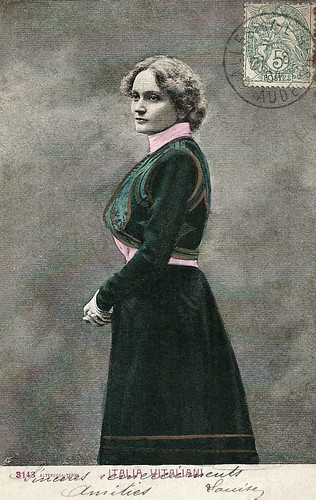
Italian postcard by Alterocca, Terni, no. 3143. Card mailed 27-8-1904 in Salles d'Aude, France. Italia Vitaliani. 'Sincères remerciements. Amitiés, Louise.'
Immortalising his mother in her Mother of Sorrows pose
Just a few years ago, the film La madre was rediscovered at the Eye Filmmuseum. In La madre, Giuseppe Sterni played the protagonist, a poor village boy with artist’s aspirations. His mother runs a bakery but she understands her son wants something else. On the invitation of another young artist, he goes to live in the city and starts a career as a painter. His female model and, even more so, her mother are gold-diggers. When his mother visits her son, she chases them, to the son’s chagrin. His fellow artist makes it clear though that his mother is his best model. Indeed, the portrait of his mother is a success in the art exhibition and brings him fame and fortune.
However, the success comes with a price to pay. Apart from some bit parts in the 1920s, Vitaliani didn’t act in film anymore but focused on the stage, and on acting teachings. She finally retired from screen and stage because of nervous exhaustion, becoming a misanthropist. In Milano, she lived alone and forgotten, and only thanks to the help of actors, writers and friends, she managed to survive her worst moments. Whoever asked her whether she would write her recollections, she answered: “I promise, I’ll never write them”.
The director of La madre, Giuseppe Sterni (1883-1952) started his stage career in a company of wandering artists in 1904, making a career in various stage companies, including that of Italia Vitaliani, rising to ‘primo attore giovane’ in 1906/7 and ‘primo attore’ in 1912, while from 1913 he became director himself of various theatrical companies. In 1916 Sterni temporarily left the stage for the cinema. He worked at several production companies, in particular at Milano Films. In addition to his film acting, he started to direct too, often playing the male leads in his own films. In addition to the mature Vitaliani, he would work with the young actresses Lina Millefleurs, Suzanne d’Armelle, Linda Pini and Paola Borboni. In 1921 he began again to direct and act in films, working with such actresses as Borboni and Carmen Boni. In 1921 he also founded his own film production company in Rome, but Sterni Film was short-lived. During the 1920s Sterni did a stage tour to New York. Here he remained, founding his own company, with a repertory ranging from William Shakespeare to Giovanni Verga, Gabriele D'Annunzio and Luigi Pirandello, and becoming popular within the Italian-American community in New York. He would stay in New York until his retirement in 1949.
La madre came out quite late in the Netherlands, in 1921, when it was released by F.A.N. Film, the distribution agency funded by film pioneer Franz Anton Nöggerath Jr. and in 1921 taken over by his former associate Piet Vermeer Sr. It was screened as a double bill together with another elder film, the Western drama The Brute Breaker (1919) with Frank Mayo. Unfortunately, many European and American films produced during the First World War had late releases in the Netherlands. At the premiere at Nöggerath’s own Bioscope-Theater in Amsterdam, the regular violin player Boris Lensky, one of the most acclaimed cinema musicians at the time in the Netherlands, gave a violin solo of Paolo Tosti’s song Ninon while accompanying the film.
During the 2018 workshop 'A Dive into the Collections of the Eye Film Museum', La madre was rediscovered as an unknown melodrama, which strikes because of the immobility of the dominating mother, thus stressing the stillness of painting vis à vis cinema, and even showing model and painting side by side. It is as if a tableau vivant, but then rather the inversed version of it, because of instead of a painting coming to life it is the filmic model becoming lifeless (a bit as in Edgar Allan Poe’s 'The Oval Portrait'). Moreover, the self-sacrificing mother who still manages the situation and is the opposite of a hyperbolic, hysterical character - thus creating a strong feeling of guilt in the son - is also a prototype of melodramatic silent cinema. The son will symbolically efface a portrait of his model and girlfriend, in order to find a canvas to immortalise his mother in her Mother of Sorrows pose.
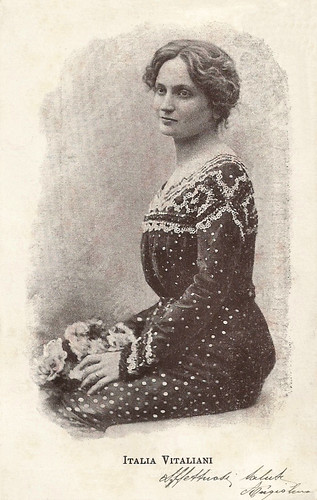
Italian postcard. Mailed 1902 in Italy: 'Affetuosi saluti'.
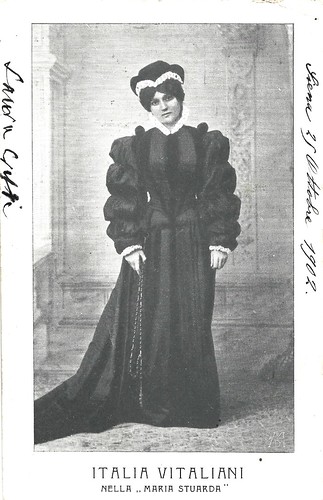
Italian postcard, mailed in Siena, 25 October 1902. Italia Vitaliani in the play 'Maria Stuarda' (Mary Stuart, 1800) by Friedrich von Schiller, which was turned into an opera by Donizetti in 1835.
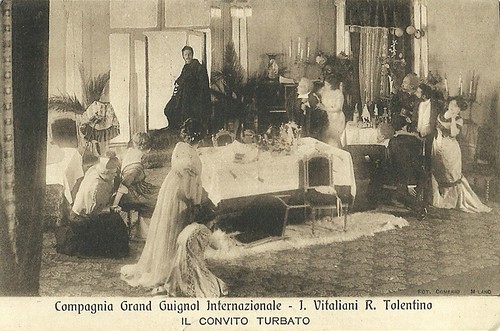
Italian postcard. Photo: Comerio, Milan. Italia Vitaliani and Riccardo Tolentino in the play 'Il convito turbato', performed by the Compagnia Grand Guignol Internazionale, c. 1910-11. This company was founded in 1910 by Tolentino and Vitaliani, after the founding of the first Italian Grand Guignol company by Alfredo Sainati in 1908. The two companies were fierce rivals, but Tolentino's company already halted in 1911.
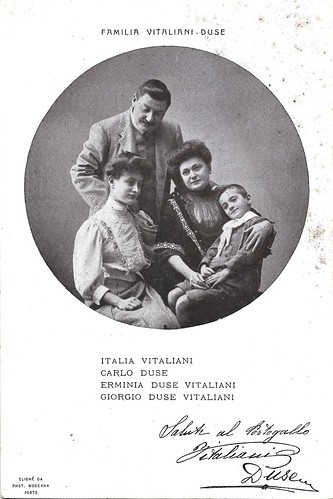
Portuguese postcard by Ed. Fabri, Porto. Photo: Moderna, Porto. Italian stage actress Italia Vitaliani with her husband Carlo Duse and their children Erminia and Giorgio. Caption: "Saluti al Portogallo, Vitaliani, Duse."
Text and Postcards: Ivo Blom.
No comments:
Post a Comment